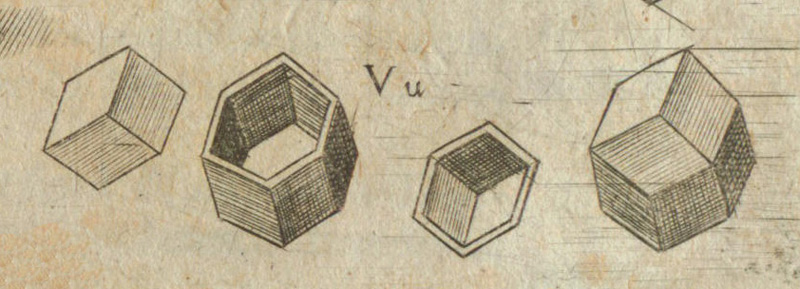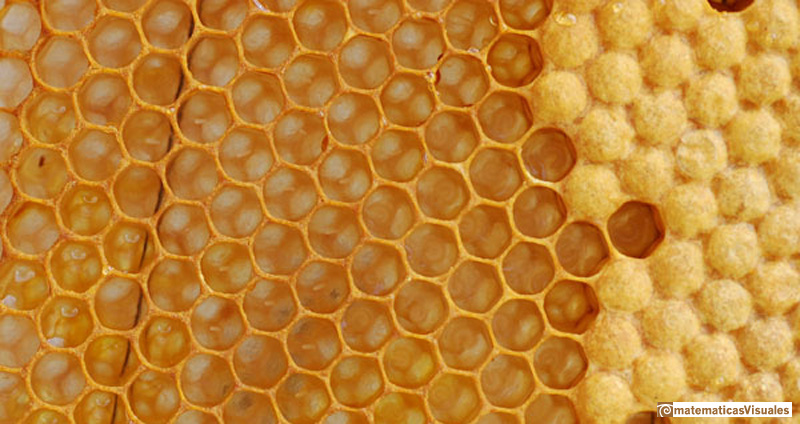- About MAA
- Membership
- MAA Publications
- Periodicals
- Blogs
- MAA Book Series
- MAA Press (an imprint of the AMS)
- MAA Notes
- MAA Reviews
- Mathematical Communication
- Information for Libraries
- Author Resources
- Advertise with MAA
- Meetings
- Competitions
- Programs
- Communities
- MAA Sections
- SIGMAA
- MAA Connect
- Students
- MAA Awards
- Awards Booklets
- Writing Awards
- Teaching Awards
- Service Awards
- Research Awards
- Lecture Awards
- Putnam Competition Individual and Team Winners
- D. E. Shaw Group AMC 8 Awards & Certificates
- Maryam Mirzakhani AMC 10 A Awards & Certificates
- Two Sigma AMC 10 B Awards & Certificates
- Jane Street AMC 12 A Awards & Certificates
- Akamai AMC 12 B Awards & Certificates
- High School Teachers
- News
You are here
Kepler and the Rhombic Dodecahedron: Honeycombs and the Rhombic Dodecahedron
Since its origins, humanity has observed nature and been fascinated by the perfection and beauty of honeycombs.
Figure 6. Bee cells with their hexagonal structure.
Pappus of Alexandria[2] (ca 290–ca 350 CE) was interested in this subject from a mathematical point of view. In the preface to Book V of his Mathematical Collection, he considered how bees build their honeycombs and wrote:
First collecting the sweets of the most beautiful flowers which grow on the earth, they make from them, for the reception of the honey, the vessels which we call honeycombs, [with cells] all equal, similar and contiguous to one another, and hexagonal in form. And that they have contrived this by virtue of a certain geometrical forethought we may infer in this way. They could necessarily think that the figures must be such as to be contiguous to one another, that is to say, to have their sides common, in order that no foreign matter could enter the interstices between them and so defile the purity of their produce. Now only three rectilinear figures would satisfy the condition, I mean regular figures which are equilateral and equiangular; for the bees would have none of the figures which are not uniform. . . . There being then three figures capable by themselves of exactly filling up the space about the same point, the bees by reason of their instinctive wisdom chose for the construction of the honeycomb the figure which has the most angles, because they conceived that it would contain more honey than either of the two others [Heath 1921, 390].
In this paragraph, Pappus dealt with two main ideas. One is the comparison of the areas or volumes of figures of the same perimeter or surface area. Are bees so clever that they expend the least amount of wax in building their honeycombs? This is a type of problem that we call isoperimetric problems. Questions of this kind are usually difficult to answer, but if you know some calculus, you can try the investigation at the bottom of this page.
Pappus’ second idea was more basic. He wrote about what we today call plane tessellations, or the question of how we can fill (or tile) the plane using regular polygons of equal size.
The following images show artistic approaches to plane tessellations. The first is based on equilateral triangles (The Alhambra of Granada); the second has a square grid (The Royal Alcazar of Seville); and the third, based on hexagons, was designed by the architect Antoni Gaudi (1852–1926, Barcelona).

Figure 7. Three artistic examples of plane tessellations. Photos by the author.
This same idea but applied instead to three-dimensional space—that is to say space tessellations—will play an important role in our study of the rhombic dodecahedron. The question will be: how can we fill space using equal polyhedra? Although the problem of finding all such polyhedra is not simple, we have an initial, simple answer: the cube tessellates such a space.
That bees used a hexagonal tessellation to build their honeycombs was a well-known fact. But more than one thousand years after Pappus, Kepler had the wisdom to look at the bottom of the cell!
Honeycomb and the bottom of cells.
We can ascertain how new ideas were born in Kepler’s inventive mind by reading his book De Nive Sexangula [The Six-Cornered Snowflake]. About the structure of the honeycomb, Kepler wrote:
If you should ask the geometers on what plan the cells of bees are built, they will reply, on a hexagonal plan. The answer is clear from a simple look at the openings or entrances, and the sides that form the cells. Each cell is surrounded by six others, and is divided from the next by a shared side. But if you observe the bottom of each cell, you will notice that it slopes into an obtuse angle formed by three planes. This bottom (which you might call the “keel”) is joined to the six sides of the cell by six other angles, three higher ones that are trilateral, just like the bottom angle of the keel, and three lower ones, in between, that are quadrilateral.[3] . . . The three planes of the keel are identical to one another, and their shape is what geometers call a rhombus [Kepler 1611, 37 and 43].
The following drawing is from Kepler's Harmonices Mundi [The Harmony of the World, Linz, 1619], another of his important books. There he drew a polyhedron made of a belt of six rhombi which we can imagine to be placed against the walls of a bee cell. (The walls of actual bee cells are taller than the belt, since the cells themselves are somewhat deeper than they are wide.) Then he added three rhombi “below” in the same way that bees close their cells (the keel), and he closed the “top” of the polyhedron with three more rhombi. (Of course, bees do not close the cell, as they need an open entrance.)

Figure 8. Drawing of a rhombic dodecahedron from Kepler's book Harmonices Mundi. In this drawing, Kepler showed the “top” of the polyhedron to the left of the belt and the keel to its right; the completed polyhedron is the fourth image in Kepler’s drawing.
What properties can we deduce from this depiction of the rhombic dodecahedron?
- The rhombic dodecahedron has 12 rhombic faces, 24 edges. and 14 vertices.
- It has six vertices at which four edges meet (where the angles of the rhombi are acute) and eight vertices at which three edges meet (where the angles of the rhombi are obtuse). Any of the eight vertices at which three edges can be viewed as the bottom tip of the keel, giving us eight “potential keels.”
- The six rhombi attached to one of the possible keels form a belt. These are the rhombi that we imagine are placed along the walls of the bee cell. In fact, the rhombic dodecahedron has four such belts since its eight potential keels can be split into four opposite pairs (with either member of the pair viewed as the actual keel of the polyhedron and the other as its top) that each give rise to a single “shared” belt that joins it together.
- The angle between any two adjacent faces of the six rhombi that form a belt is 120º. It can also be proved using basic trigonometry that the angle between two adjacent faces of the rhombic dodecahedron is 120º. An optional investigation showing why this is the case is shared later in this article.
If we now imagine a layer of bee cells, we can put a rhombic dodecahedron inside each cell.
But Kepler went even further and wrote:
It should also be observed that the cells are arranged in two layers, with the openings facing opposite directions; the backs adjoining one another and closely packed; and the corner of each keel in one layer fitted into the three corners of the three keels in the other. By this workmanship, not only does each cell share six sides with the ones surrounding it in the same layer, but also three planes at the bottom with three other cells from the opposite layer. Thus, each bee has nine neighbors, with each of whom it shares a dividing wall [Kepler 1611, 43].
In other words, underneath our imagined layer of bee cells, each of which contains a rhombic dodecahedron, we can imagine a second layer of bee cells. Then we can imagine that inside this second layer of hexagonal cells, we put another layer of rhombic dodecahedra.

Figure 9. Bee cells in two layers.
Why not add a third and a fourth layer, and so on? In other words, we can imagine infinitely many layers of rhombic dodecahedra. By this simple thought experiment, we can see that this beautiful polyhedron has a surprising property: rhombic dodecahedra tessellate space.
So far, we have seen that Kepler was aware that the way that bees build their cells leads us to a new polyhedron that, like the cube, tessellates space. We will see later in this article that Kepler had an even deeper understanding of the mathematical properties of the rhombic dodecahedron and examine how his creative mind thought about it from points of view other than honeycombs. But before we explore Kepler's other approaches, it will be helpful to our imaginations (and perhaps inspiring!) to build some models of this wonderful polyhedron.
|
TO INVESTIGATE A property of minima in honeycombs. Using derivatives, we can solve an isoperimetric problem that interested 18th-century mathematicians such as Colin Maclaurin (1698–1708): We want to close a hexagonal prism as bees do, using three congruent rhombi. What is the shape of the three such rhombi with minimum total surface area? |
[2] You can read more about Pappus in note 16 by J. Bromberg and G. Bleichmar in [Kepler 1611, 141].
[3] In Kepler's description of the “six other angles” of the keel as “three higher ones that are trilateral” and “three lower ones, in between that are quadrilateral,” it appears that he may have been looking at the bee cell ‘upside down,’ as if the base of the cell was dangling from a string with the vertices at which three faces meet literally higher than the vertices at which four faces meet. This is easier to see by holding an actual physical model of the rhombic dodecahedron.
Roberto Cardil (matematicasVisuales), "Kepler and the Rhombic Dodecahedron: Honeycombs and the Rhombic Dodecahedron," Convergence (March 2022)






